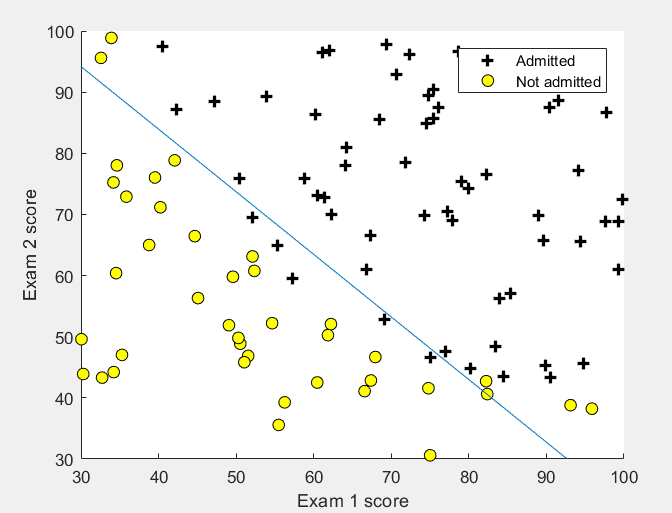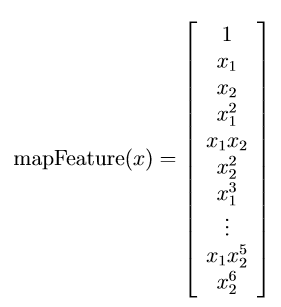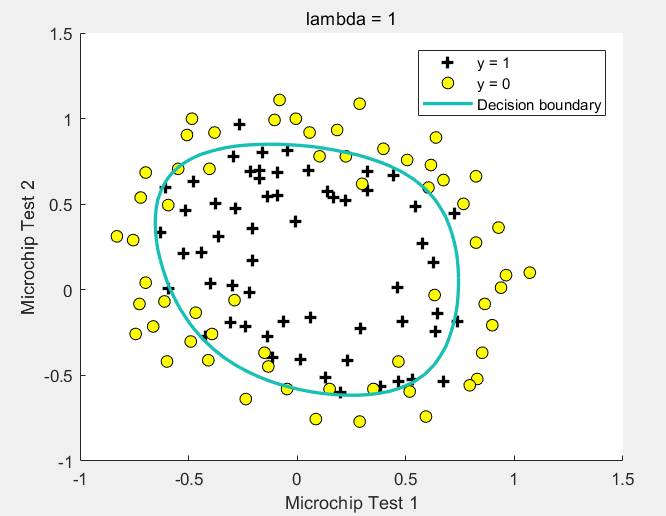机器学习作业(二)逻辑回归——Matlab实现
题目太长啦!文档下载【传送门】
第1题
简述:实现逻辑回归。
第1步:加载数据文件:
data = load('ex2data1.txt');
X = data(:, [1, 2]); y = data(:, 3);
plotData(X, y);
% Put some labels
hold on;
% Labels and Legend
xlabel('Exam 1 score')
ylabel('Exam 2 score')
% Specified in plot order
legend('Admitted', 'Not admitted')
hold off;
第2步:plotData函数实现训练样本的可视化:
function plotData(X, y) % Create New Figure figure; hold on; pos = find(y==1); neg = find(y==0); plot(X(pos,1),X(pos,2),'k+','LineWidth',2,'MarkerSize',7); plot(X(neg,1),X(neg,2),'ko','MarkerFaceColor','y','MarkerSize',7); hold off; end
第3步:计算代价函数和梯度:
% Setup the data matrix appropriately, and add ones for the intercept term [m, n] = size(X); % Add intercept term to x and X_test X = [ones(m, 1) X]; % Initialize fitting parameters initial_theta = zeros(n + 1, 1); % Compute and display initial cost and gradient [cost, grad] = costFunction(initial_theta, X, y);
第4步:实现costFunction函数:
function [J, grad] = costFunction(theta, X, y) m = length(y); % number of training examples J = 0; grad = zeros(size(theta)); h = sigmoid(X*theta); J = 1/m*(-y'*log(h)-(1-y')*log(1-h)); grad = 1/m*(X'*(h-y)); end
第5步:实现sigmoid函数:
function g = sigmoid(z) g = zeros(size(z)); g = 1./(1+exp(-z)); end
第6步:使用fminunc函数求θ和Cost:
% Set options for fminunc
options = optimset('GradObj', 'on', 'MaxIter', 400);
% Run fminunc to obtain the optimal theta
% This function will return theta and the cost
[theta, cost] = ...
fminunc(@(t)(costFunction(t, X, y)), initial_theta, options);
% Print theta to screen
fprintf('Cost at theta found by fminunc: %f\n', cost);
fprintf('theta: \n');
fprintf(' %f \n', theta);
% Plot Boundary
plotDecisionBoundary(theta, X, y);
% Put some labels
hold on;
% Labels and Legend
xlabel('Exam 1 score')
ylabel('Exam 2 score')
% Specified in plot order
legend('Admitted', 'Not admitted')
hold off;
第7步:实现plotDecisionBoundary函数:
function plotDecisionBoundary(theta, X, y)
% Plot Data
plotData(X(:,2:3), y);
hold on
if size(X, 2) <= 3
% Only need 2 points to define a line, so choose two endpoints
plot_x = [min(X(:,2))-2, max(X(:,2))+2];
% Calculate the decision boundary line
plot_y = (-1./theta(3)).*(theta(2).*plot_x + theta(1));
% Plot, and adjust axes for better viewing
plot(plot_x, plot_y)
% Legend, specific for the exercise
legend('Admitted', 'Not admitted', 'Decision Boundary')
axis([30, 100, 30, 100])
else
% Here is the grid range
u = linspace(-1, 1.5, 50);
v = linspace(-1, 1.5, 50);
z = zeros(length(u), length(v));
% Evaluate z = theta*x over the grid
for i = 1:length(u)
for j = 1:length(v)
z(i,j) = mapFeature(u(i), v(j))*theta;
end
end
z = z'; % important to transpose z before calling contour
% Plot z = 0
% Notice you need to specify the range [0, 0]
contour(u, v, z, [0, 0], 'LineWidth', 2)
end
hold off
end
运行结果:

第8步:预测[45 85]成绩的学生,并计算准确率:
prob = sigmoid([1 45 85] * theta);
fprintf(['For a student with scores 45 and 85, we predict an admission ' ...
'probability of %f\n'], prob);
fprintf('Expected value: 0.775 +/- 0.002\n\n');
% Compute accuracy on our training set
p = predict(theta, X);
fprintf('Train Accuracy: %f\n', mean(double(p == y)) * 100);
fprintf('Expected accuracy (approx): 89.0\n');
fprintf('\n');
第9步:实现predict预测函数:
function p = predict(theta, X) m = size(X, 1); % Number of training examples p = zeros(m, 1); p = round(sigmoid(X*theta)); end
运行结果:

第2题
简述:通过正规化实现逻辑回归。
第1步:加载数据文件:
data = load('ex2data2.txt');
X = data(:, [1, 2]); y = data(:, 3);
plotData(X, y);
% Put some labels
hold on;
% Labels and Legend
xlabel('Microchip Test 1')
ylabel('Microchip Test 2')
% Specified in plot order
legend('y = 1', 'y = 0')
hold off;
第2步:正规化逻辑回归:
% Note that mapFeature also adds a column of ones for us, so the intercept
% term is handled
X = mapFeature(X(:,1), X(:,2));
% Initialize fitting parameters
initial_theta = zeros(size(X, 2), 1);
% Set regularization parameter lambda to 1
lambda = 1;
% Compute and display initial cost and gradient for regularized logistic
% regression
[cost, grad] = costFunctionReg(initial_theta, X, y, lambda);
fprintf('Cost at initial theta (zeros): %f\n', cost);
fprintf('Gradient at initial theta (zeros) - first five values only:\n');
fprintf(' %f \n', grad(1:5));
第3步:mapFeature函数实现特征设置:
function out = mapFeature(X1, X2)
degree = 6;
out = ones(size(X1(:,1)));
for i = 1:degree
for j = 0:i
out(:, end+1) = (X1.^(i-j)).*(X2.^j);
end
end
end
其设置的特征值为:

第4步:实现costFunctionReg函数:
function [J, grad] = costFunctionReg(theta, X, y, lambda) % Initialize some useful values m = length(y); % number of training examples % You need to return the following variables correctly J = 0; grad = zeros(size(theta)); theta2 = theta(2:end,1); h = sigmoid(X*theta); J = 1/m*(-y'*log(h)-(1-y')*log(1-h)) + lambda/(2*m)*sum(theta2.^2); theta(1,1) = 0; grad = 1/m*(X'*(h-y)) + lambda/m*theta; end
第5步:使用fminunc函数求θ和Cost,并预测准确率:
% Initialize fitting parameters
initial_theta = zeros(size(X, 2), 1);
% Set regularization parameter lambda to 1 (you should vary this)
lambda = 1;
% Set Options
options = optimset('GradObj', 'on', 'MaxIter', 400);
% Optimize
[theta, J, exit_flag] = ...
fminunc(@(t)(costFunctionReg(t, X, y, lambda)), initial_theta, options);
% Plot Boundary
plotDecisionBoundary(theta, X, y);
hold on;
title(sprintf('lambda = %g', lambda))
% Labels and Legend
xlabel('Microchip Test 1')
ylabel('Microchip Test 2')
legend('y = 1', 'y = 0', 'Decision boundary')
hold off;
% Compute accuracy on our training set
p = predict(theta, X);
fprintf('Train Accuracy: %f\n', mean(double(p == y)) * 100);
fprintf('Expected accuracy (with lambda = 1): 83.1 (approx)\n');
运行结果:

![]()



